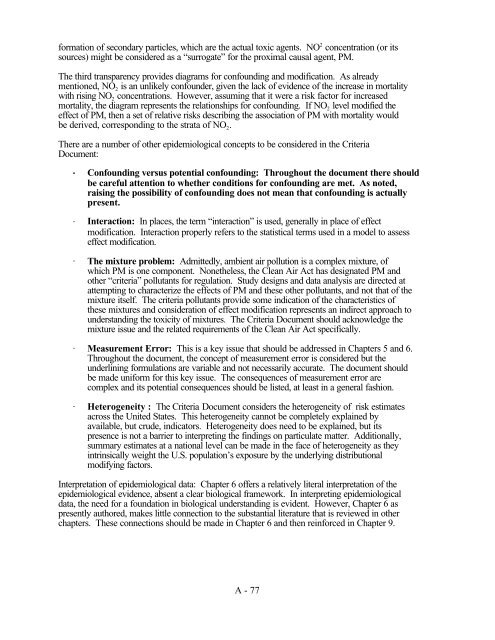Review of the Air Quality Criteria Document for Particulate Matter
Review of the Air Quality Criteria Document for Particulate Matter
Review of the Air Quality Criteria Document for Particulate Matter
- No tags were found...
Create successful ePaper yourself
Turn your PDF publications into a flip-book with our unique Google optimized e-Paper software.
<strong>for</strong>mation <strong>of</strong> secondary particles, which are <strong>the</strong> actual toxic agents. NO 2 concentration (or itssources) might be considered as a “surrogate” <strong>for</strong> <strong>the</strong> proximal causal agent, PM.The third transparency provides diagrams <strong>for</strong> confounding and modification. As alreadymentioned, NO 2 is an unlikely confounder, given <strong>the</strong> lack <strong>of</strong> evidence <strong>of</strong> <strong>the</strong> increase in mortalitywith rising NO 2 concentrations. However, assuming that it were a risk factor <strong>for</strong> increasedmortality, <strong>the</strong> diagram represents <strong>the</strong> relationships <strong>for</strong> confounding. If NO 2 level modified <strong>the</strong>effect <strong>of</strong> PM, <strong>the</strong>n a set <strong>of</strong> relative risks describing <strong>the</strong> association <strong>of</strong> PM with mortality wouldbe derived, corresponding to <strong>the</strong> strata <strong>of</strong> NO 2 .There are a number <strong>of</strong> o<strong>the</strong>r epidemiological concepts to be considered in <strong>the</strong> <strong>Criteria</strong><strong>Document</strong>:· Confounding versus potential confounding: Throughout <strong>the</strong> document <strong>the</strong>re shouldbe careful attention to whe<strong>the</strong>r conditions <strong>for</strong> confounding are met. As noted,raising <strong>the</strong> possibility <strong>of</strong> confounding does not mean that confounding is actuallypresent.· Interaction: In places, <strong>the</strong> term “interaction” is used, generally in place <strong>of</strong> effectmodification. Interaction properly refers to <strong>the</strong> statistical terms used in a model to assesseffect modification.· The mixture problem: Admittedly, ambient air pollution is a complex mixture, <strong>of</strong>which PM is one component. None<strong>the</strong>less, <strong>the</strong> Clean <strong>Air</strong> Act has designated PM ando<strong>the</strong>r “criteria” pollutants <strong>for</strong> regulation. Study designs and data analysis are directed atattempting to characterize <strong>the</strong> effects <strong>of</strong> PM and <strong>the</strong>se o<strong>the</strong>r pollutants, and not that <strong>of</strong> <strong>the</strong>mixture itself. The criteria pollutants provide some indication <strong>of</strong> <strong>the</strong> characteristics <strong>of</strong><strong>the</strong>se mixtures and consideration <strong>of</strong> effect modification represents an indirect approach tounderstanding <strong>the</strong> toxicity <strong>of</strong> mixtures. The <strong>Criteria</strong> <strong>Document</strong> should acknowledge <strong>the</strong>mixture issue and <strong>the</strong> related requirements <strong>of</strong> <strong>the</strong> Clean <strong>Air</strong> Act specifically.· Measurement Error: This is a key issue that should be addressed in Chapters 5 and 6.Throughout <strong>the</strong> document, <strong>the</strong> concept <strong>of</strong> measurement error is considered but <strong>the</strong>underlining <strong>for</strong>mulations are variable and not necessarily accurate. The document shouldbe made uni<strong>for</strong>m <strong>for</strong> this key issue. The consequences <strong>of</strong> measurement error arecomplex and its potential consequences should be listed, at least in a general fashion.· Heterogeneity : The <strong>Criteria</strong> <strong>Document</strong> considers <strong>the</strong> heterogeneity <strong>of</strong> risk estimatesacross <strong>the</strong> United States. This heterogeneity cannot be completely explained byavailable, but crude, indicators. Heterogeneity does need to be explained, but itspresence is not a barrier to interpreting <strong>the</strong> findings on particulate matter. Additionally,summary estimates at a national level can be made in <strong>the</strong> face <strong>of</strong> heterogeneity as <strong>the</strong>yintrinsically weight <strong>the</strong> U.S. population’s exposure by <strong>the</strong> underlying distributionalmodifying factors.Interpretation <strong>of</strong> epidemiological data: Chapter 6 <strong>of</strong>fers a relatively literal interpretation <strong>of</strong> <strong>the</strong>epidemiological evidence, absent a clear biological framework. In interpreting epidemiologicaldata, <strong>the</strong> need <strong>for</strong> a foundation in biological understanding is evident. However, Chapter 6 aspresently authored, makes little connection to <strong>the</strong> substantial literature that is reviewed in o<strong>the</strong>rchapters. These connections should be made in Chapter 6 and <strong>the</strong>n rein<strong>for</strong>ced in Chapter 9.A - 77
















